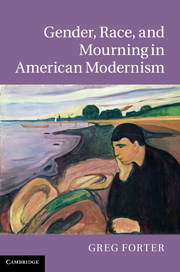Book contents
- Frontmatter
- Contents
- Acknowledgements
- Introduction
- 1 Gender, melancholy, and the whiteness of impersonal form in The Great Gatsby
- 2 Redeeming violence in The Sun Also Rises: phallic embodiment, primitive ritual, fetishistic melancholia
- 3 Versions of traumatic melancholia: the burden of white man's history in Light in August and Absalom, Absalom!
- 4 The Professor's House: primitivist melancholy and the gender of utopian forms
- Afterword
- Notes
- Index
1 - Gender, melancholy, and the whiteness of impersonal form in The Great Gatsby
Published online by Cambridge University Press: 21 April 2011
- Frontmatter
- Contents
- Acknowledgements
- Introduction
- 1 Gender, melancholy, and the whiteness of impersonal form in The Great Gatsby
- 2 Redeeming violence in The Sun Also Rises: phallic embodiment, primitive ritual, fetishistic melancholia
- 3 Versions of traumatic melancholia: the burden of white man's history in Light in August and Absalom, Absalom!
- 4 The Professor's House: primitivist melancholy and the gender of utopian forms
- Afterword
- Notes
- Index
Summary
Fitzgerald's The Great Gatsby (1925) provides an illuminating starting point for this investigation. It is a powerful example of a work that embeds within itself an account of the material processes giving rise to modern white manhood, a record of the losses entailed in that emergence, and a poignant if politically troubling effort to grieve those losses. The book's initial, materialist account takes the form of an allegory about the loss of male creativity: a residual, lyrically creative masculinity that's figured through tropes of beneficent femininity (i.e., Gatsby) is destroyed by the representative of an emergent male “hardness” that's linked, paradoxically, to a traditional ruling class (i.e., Tom Buchanan). Though this allegory of loss entails a condensation, displacement, and representational disfigurement of the historical processes with which it is concerned, it nonetheless offers a trenchant critique of how the traditional ruling class allies itself with an emergent regime of gender to extend its dominion over the socially vulnerable (especially over women and “feminine” men).
This allegory is overwritten, however, by a second and more disturbing set of imperatives. Because Fitzgerald had also internalized the demands of the new gender order, his novel begins to disparage the “femininity” it values in its protagonist, defending against it, too, with increasing emphasis on Gatsby's “masculine” qualities.
- Type
- Chapter
- Information
- Gender, Race, and Mourning in American Modernism , pp. 15 - 53Publisher: Cambridge University PressPrint publication year: 2011



